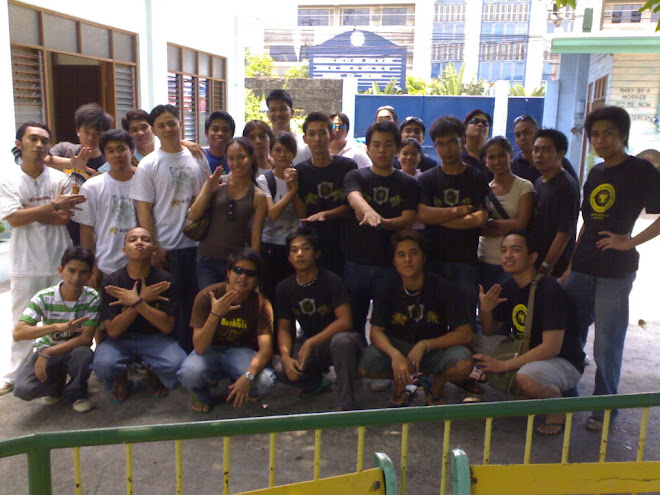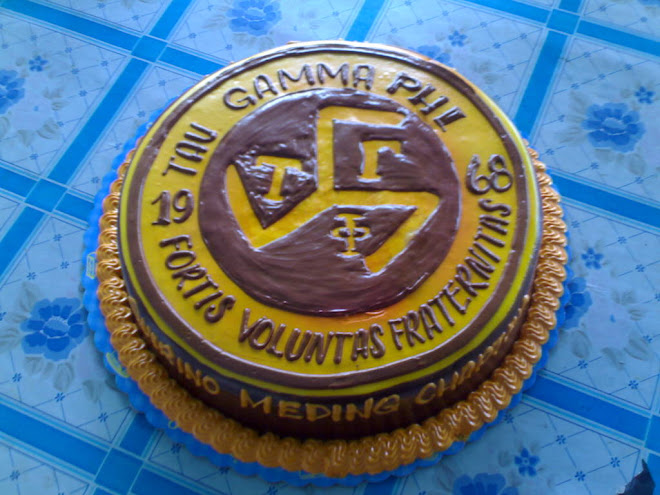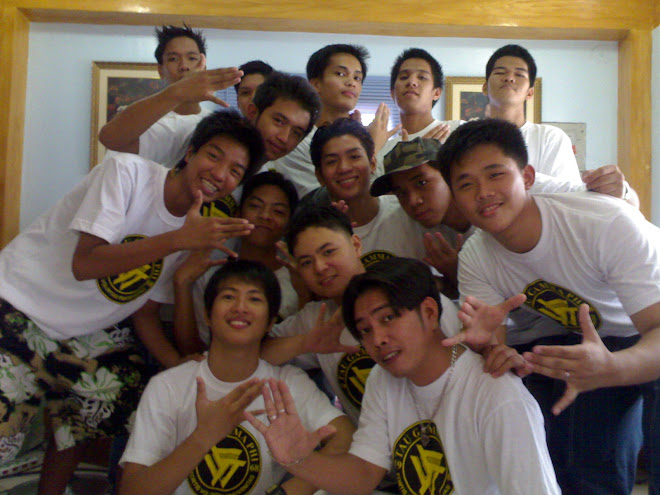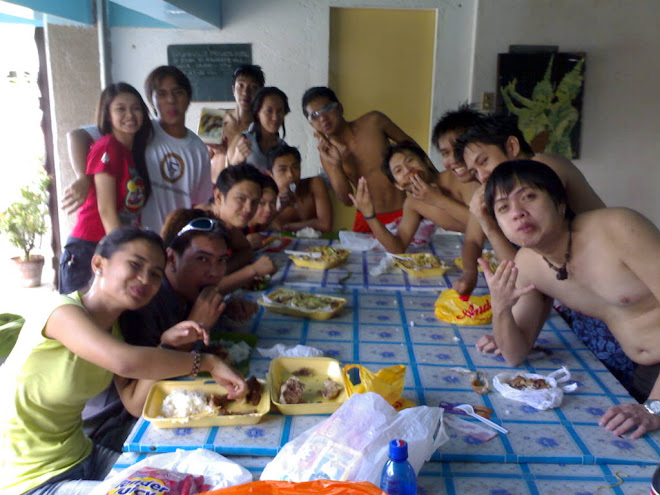Friday, January 2, 2009
History of the Chapter
Wednesday, December 3, 2008
Chapter's History
Triskelion Youth Movement
Another first in the history of fraternity in the Philippines. True to its objective of changing the elitist orientation of the fraternity system, the Tau Gamma Phi decided to open its doors to aspiring youth in the community through the Triskelion Youth Movement (T.Y.M.), so that they too, who temporarily stopped pursuing higher education to continue their chosen vocation, may also share in the glory of the Tau Gamma Phi. Another milestone in fraternity history, not just in the Philippines but probably worldwide. Again conceptualized and conceived by the Fraternity's Metro Manila Regional Council through the enigmatic leadership of then Secretary-General Atty. Ramoncito "Monching" Ocampo.
Like the Junior Triskelions, the Triskelion Youth Movement was also born out of necessity, they have the same motive when first conceptualized which is to regenerate the dwindling member population, but they have different reasons for coming into being. Unlike the Junior Triskelion which has been founded solely for the continued Fraternity's existence on campuses, the T.Y.M. is hatched to provide the Fraternity's much needed muscle and strength for its own survival.
As Triskelions they also persevered to preserve the Fraternity's existence during its trying times. Numerous notable alumni of the Tau Gamma Phi actually started their Fraternal Journey as Triskelions in the T.Y.M. It just shows how the Tau Gamma Phi Fraternity is constantly evolving to the situation of the times in order to suit the needs and survival of the TriskelionThe Junior Triskelions - A milestone in frat history
Struggling from the effects of Martial Law which suspended all fraternal and organizational activity within the collegiate levels and the arrests of all militant students, the Fraternity decided to stay low to avoid being tagged as a subversive group working for the Communists out to destabilize the government, although a lot of its members went underground and took up arms to join the New People's Army, the armed paramilitary group of the Communist Party of the Philippines, in the mountains and jungles. These developments temporarily freezed the recruitment of new members, and without fresh bloods to replace the old ones, these resulted in the dwindling down of membership population, due to graduating members or just simply dropping out of school.
The Fraternity's Metro Manila Regional Council at that time, led by Secretary-General Atty. Ramoncito "Monching" Ocampo, explored the idea to tap the younger generations. They decided to recruit in the High School sector. This gave birth to the "Junior Tau Gamma Phi" or better known as the "Junior Triskelions", founded at San Beda College - High School in 1975, where Triskelion Boyet Gorospe was one of the founders. The rationale behind this is, to be able to solve the recruitment problems in the collegiate levels since these High School students will eventually graduate and attend college in the future. This initiative was both simple and effective but the recruitment problem was somehow solved. A milestone in fraternity history in the Philippines, the Tau Gamma Phi was the first fraternity to have high school students as equal members. When other fraternities learned about this successful fraternal venture they followed suit.
The Raid
The Early Chapters and the 1970's - A Decade of Awakening
Reaping the fruits of labor, discipline and confidence of the University of the Philippines Chapter, the Triskelion principles reverberated outside of the U.P.-Diliman campus, which signaled the advancement of the fraternity. The inspired U.P. Chapter founded a new home for Triskelions at the Philippine Maritime Institute (P.M.I.) on August 3, 1969. Seven months later, another group of students at the Far Eastern Aeronautics and Technical Institute (F.E.A.T.I.) now known only as FEATI University also embraced the Tenets and principles of the Triskelion on March 5, 1970. Following the success at the P.M.I. and FEATI University, the Fraternity explored at the Mapua Institute of Technology (M.I.T.) on April 1970, and was later revived on December 2, 1973. While at the National University (Philippines) (N.U.) the Fraternity readily found acceptance on October 23, 1970 and the Philippine School of Business Administration (P.S.B.A.) - Manila, on August 21, 1971. Following these developments came a succession of chapter foundations.
In the next few years many other chapters would follow suit. Trying to find a Christian home the Tau Gamma Phi was founded in the two biggest Catholic universities in the nation, the University of Santo Tomas (U.S.T.) on March 1, 1971, and at the Adamson University (Ad.U.) on July 8, 1973, and in that same year National College of Business and Arts (N.C.B.A.) - Manila on October 1973. The year 1974 saw the series of foundations and gave birth to the chapters at the University of the East (U.E.) - Manila and also on January 21, at the Manuel L. Quezon University (M.L.Q.U.) came on October 8 and at the San Sebastian College (S.S.C.) on November 19. These schools,colleges and universities will ultimately complete the phenomenal growth of the Fraternity in the early 1970s, but it didn't stop there. The meteoric rise of the Tau Gamma Phi Fraternity in that decade have only just began.
After the 3rd Regional Convention in 1975 at Narvaez Farm in Laguna, another school embraced the Tenets and the Codes of Conduct of the Fraternity. The Far Eastern University (F.E.U.) was founded on July 27, 1975, the 13th and only chapter found in that year. Then the next year, 1976, six succeeding chapters have been founded one after the other. They are the Philippine College of Arts and Trades (P.C.A.T.), now the Technological University of the Philippines (T.U.P.) on February 22, 1976, the University of Manila (U.M.) on March 7, 1976, the Central Colleges of the Philippines (C.C.P.) on July 11, 1976, the Philippine College of Criminology (P.C.Cr.) on August 7, 1976, the Lyceum of the Philippines on August 15, 1976, the Gregorio Araneta University Foundation (G.A.U.F.), now the De La Salle Araneta University on October 15, 1976, making 1976 the most productive year for the Fraternity.
Then a few more chapters had been added in the later part of the 1970s. The De Ocampo Memorial College (D.O.M.C.) on August 30, 1977, the Eulogio "Amang" Rodriguez Institute of Science and Technology (E.A.R.I.S.T.) on March 19, 1978, the Philippine Air Transport and Training Services (P.A.T.T.S.), now called PATTS College of Aeronautics on September 5, 1978, and to close the decade with a bang, the Philippine Merchant Marine School (P.M.M.S.) - Manila on March 2, 1979, and the Perpetual Help College of Rizal (P.H.C.R.) - Las Piñas, now University of Perpetual Help System on August 9, 1979,-Lyceum of Batangas on September 21,1979 were established
The 1970s is the most challenging but also the most fruitful decade for the Tau Gamma Phi being a young Fraternity. This trend of chapter foundations goes on through the 1980s and 1990s, and until now, in the new millennium, new chapters in schools, colleges, universities and even communities in some far flung corners of the Philippines were being established. Making it the biggest and most dynamic fraternity in the country.
The Four Founding Fathers
By now only four of the original six founders were left to continue the saga of their vision for the Fraternity, more famously known to its members as the "The Four Founding Fathers" or just plain "FFF" for short. They are Rodrigo "Rod" Sta. Maria Confesor, Roy Alolor Ordinario, Talek Hamias Pablo, and Vedasto "Tito" Sario Venida. Convinced of the success of a unified endeavor, the Founding Fathers proved to be the real pillars that was later manifested in the succeeding recognition of the Fraternity at the University of the Philippines. Showing the public a discipline and collective determination and good examples, the Fraternity got the attention and respect of the University of the Philippines student body so that in the process an enlightened group headed by Triskelion Jun Rodriguez took the leap-of-faith forward by inaugurating the Fraternity in 1968 at Cavite - the first site of formal initiation, to be the first "Founding Batch" of the Tau Gamma Phi Fraternity. Under the leadership of Founding Father Rod Confessor as the first Grand Triskelion, much influence and action came to the history of the fraternity which reached to the heights by gaining control of the College of Arts and Sciences (C.A.S.) student body. The C.A.S. at that time was the dominant college within the University with regards to the logic of numbers, which therefore proved that the Tau Gamma Phi is a group to reckon with.
The Founding Fathers proved to be the paradigm of leadership as the Fraternity attained official recognition at the University of the Philippines. By showing discipline, collective determination and good examples, the Fraternity further grabbed the attention and respect of the University of the Philippines students. Much influence and action came to the history of the fraternity which reached to the heights by gaining control of the College of Arts and Sciences (C.A.S.) student body. The C.A.S. at that time was the dominant college within the University with regards to the logic of numbers, which therefore proved that the Tau Gamma Phi is a group to reckon with.















.jpg)
.jpg)
.jpg)
.jpg)
.jpg)
.jpg)
.jpg)

.jpg)
.jpg)
